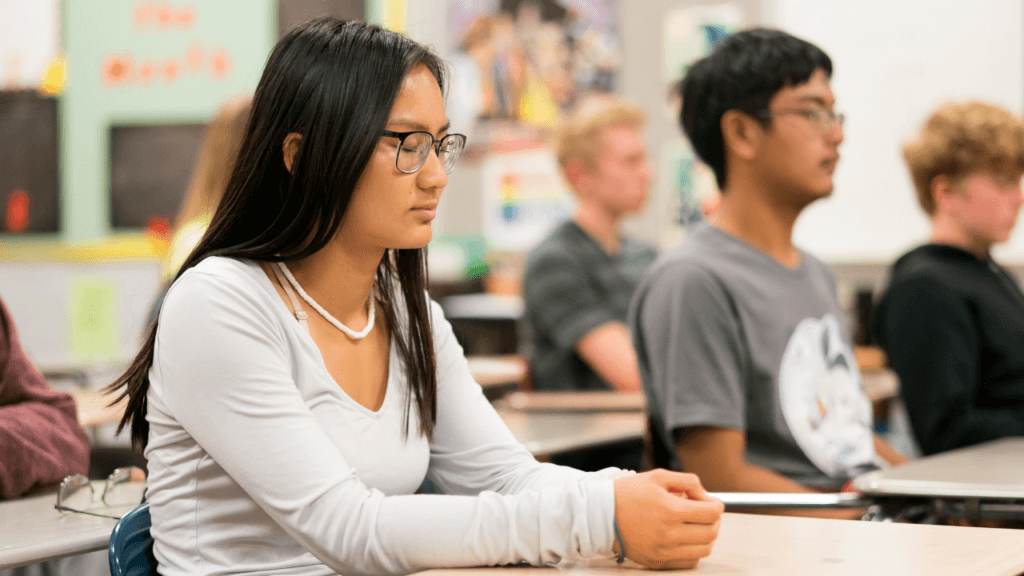Ding. The chime reverberates throughout the classroom, cuing the learners that it’s time for deep breathing.
“Inhale. Hold. Exhale,” a student calmly instructs the rest of the class, leading the day’s breathing exercise as they each reflect on how they are feeling.
Then a beautiful cacophony of student voices passionately and chorally yell out their class affirmation: “I am enough! I am worth it! I am resilient!”
As an educator, I have continually asked myself what is the most effective way to begin a class after students come into a common learning space from a variety of environments and activities: My findings–a daily mindfulness practice before engaging in academic learning and discovery. It has repeatedly cultivated a climate of synergy, positivity and concentration.
What is Mindfulness?
Mindfulness can be both a tool and a practice in one’s life. The art of mindful living is one of slowing down, paying attention to the present moment, and being aware of oneself and one’s surroundings without judgment. It entails awareness of thoughts, feelings and physical sensations while gently and intentionally approaching each moment with more awareness and presence.
What Does Mindfulness Involve?
Mindfulness has several key components. Breathing is central to a mindful practice, being an aid for slowing and calming down along with centering oneself in the present moment. Mindfulness also creates space to recognize thoughts and emotions, enhancing self-awareness and introspection. Another aspect of mindfulness is paying attention to one’s surroundings through awareness of different senses: smells, sounds, tastes, sights, feelings. A body scan can also be an important component of mindfulness to bring more attention to different parts of the body.
Why Mindfulness?
As a school, a fundamental purpose is to educate children. Reducing social and emotional learning (SEL) barriers and building the necessary skill sets in domains such as self-awareness, self-regulation, social-awareness and relationships are an effective way to improve learning efficiency and outcomes in the classroom and beyond. Within this same realm lies mindfulness, helping to reach the whole child and not just the academics. Such skills and practice greatly influence the resilience of any growing human.
What are Potential Benefits?
Mindfulness influences the mind and body. Research suggests that a long-term practice of mindfulness can have a variety of potential benefits:
- Improving attention skills and memory
- Supporting the immune system
- Reducing negative emotions and stress
- Enhancing decision-making and relationships
How Can It be Used in School?
Mindfulness can be modeled, taught and practiced in a variety of settings inside and outside of the classroom including lunch or snack time, during class, time outdoors, in sports or other extracurricular activities. Many schools have begun implementing some element of mindfulness into their schedules and curriculums. Bidyut Bose, Ph.D., founder of Niroga Institute and lead author of CASEL-approved Dynamic Mindfulness curriculum, integrates mindful practices with intentional movement, helping to restore balance in the body and mind by clearing stress and tension.
Additionally, founder of Neural Education, Dr. Kieran O’Mahony, discusses the several elements of learning and the brain in his book, The Brain-Based Classroom. He explains the importance of keeping the brain functioning in the prefrontal cortex. When triggered, brain activity will shift to the survival/reactive part of the brain. For any continued learning to take place, the brain activity must find its way back to the prefrontal cortex. Mindfulness can be a great tool to utilize and help calm the mind and body to come back to full cognitive function
All in all, students face many stressors whether it be negative emotions, interpersonal conflicts or high demands. A mindfulness practice learned at an early age of childhood and teenage years can create a healthier and happier life path. Mindfulness in the classroom can benefit students now and in their future.
So let’s begin–breathe in!
Resources
Chen, Wen, Ph.D. “Studying Mindfulness Through Neuroimaging Studies: Current Funding Opportunities.” National Center for Complementary and Integrative Health. 25 Mar. 2021. 19 July 2022 https://www.nccih.nih.gov/research/blog/studying-mindfulness-through-neuroimaging-studies-current-funding-opportunities.
“Mindfulness Defined.” Greater Good Magazine: Science-Based Insights for a Meaningful Life. University of California, Berkeley, 2022. 7 July 2022 https://greatergood.berkeley.edu/topic/mindfulness/definition#why-practice-mindfulness.
“Dynamic Mindfulness.” Niroga Institute. 7 July 2022 https://www.niroga.org/.
O’Mahony, Kieran, Ph.D. The Brain-Based Classroom: Accessing Every Child’s Potential Through Educational Neuroscience. New York: Routledge, 2021.

